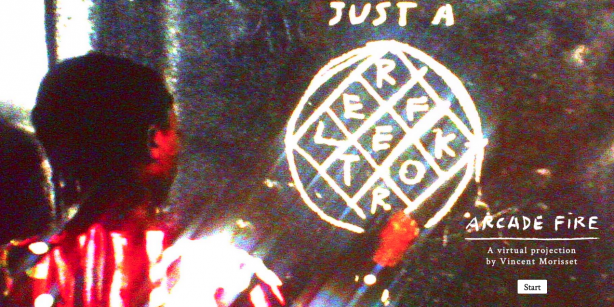 Music
Music
TRENDSPOTTING: Arcade Fire's Reflektor explores the possibilities and limitations of interactive video
by Richard Trapunski
September 27, 2013
The MTV Generation is over, but music videos aren’t dead.
While the music-video pioneer focuses its programming on pregnant teens and Catfish scams, those now stodgy, old-fashioned clips set to music thrive online both artistically and commercially. Record labels have finally found a way to profit off the once-anarchistic streaming video wild west (four letters: VEVO), while YouTube has transcended (or at least bolstered) its former status as a platform for amateurs, DIYers, and fame-seekers to become one of the most widely-used music streaming sites, even as services like RDIO and Spotify offer quality and no autoplaying 15-second ads in some hard-to-find tab.
And yet as technology continues to improve and TV, movies, and other media adapt to meet it, the music video hasn’t made many leaps since Bob Dylan first voicelessly asked “LEADERS ? ? ?”
In that regard, Arcade Fire are innovators. Always ones to use their unexpected influence to push themselves into interesting and rewarding directions, the Montreal indie-gone-mainstreamers were one of the first to explore the web’s technological capabilities to go beyond the usual music video paradigm. The band teamed with web-friendly director (director 2.0?) Vincent Morisset to create one of the first interactive videos a good five years ago with “Neon Bible,” but it wasn’t until The Wilderness Downtown, Chris Milk’s “interactive short film” set to their “We Used To Wait” during the height of Suburbs mega-hype mania that the new medium truly got its moment in the sun.
The video was an impressive bending of music video and even programming-language technology to the point that it required upgrading to a new browser, the then-new Google Chrome, which in turn led many to wonder if Arcade Fire was in bed with Google (if they weren’t then, they are now). But the html5 “Chrome Experiment,” for all its intricately timed browser-window choreography and Google Street View-driven future-nostalgia, you couldn’t help but watch it and think, sure, this is cool now, but it’s going to look dated as all hell in just a few years.
And right on cue, a few years later, the band has returned with another interactive video, Just A Reflektor, for their ubiquitous new single “Reflektor.” It’s even more impressive than the last one, a melding of webcam, html5, and smartphone/tablet technology and, once again, it’s pushing the form more than any other artist. In the meantime, little else has shown up to emphasize the expected quaintness of their early experiments. The Wilderness Downtown compelled me to update my web browser, Just A Reflektor caused me to update my iOS.
True, it’s not as if music videos have been totally resistant to technology. The distinctly 21st century phenomenon of the lyric video, for instance, exists to curb the instant upload of poor-quality song-stream premieres to YouTube. And viral videos have been instrumental in propelling bands like OK Go and Hollerado beyond likeable power pop outfits (never the most marketable genre, despite all the pop). And sure, MTV’s O Music Awards has a Best Interactive Music Video category, but it’s hard to argue that it represents a cultural sea change in the medium’s entrenchment when it also gives out statues for Best Artist With A Cameraphone and Too Much Ass for TV.
It’s a stretch to say no one is exploring the possibilities of interactive video, but the reluctance to reach beyond novelty recalls a Choose Your Own Adventure story or the early days of Flash more than any real forward-thinking innovation. Change a backdrop here, a camera angle there – it doesn’t amount to much. Hell, just look at this Tanlines video.
So why have so few artists taken Arcade Fire’s lead and embraced the possibilities of widespread, accessible technology to create music videos? The easy answer is that it’s expensive, or that it’s hard. Both are valid answers, though not all interactive videos have been created by titans. But maybe that just scratches the surface. In a brilliant analysis of Just A Reflektor, the Atlantic argues that the multi-device presentation actually masks a sneaky, subversive anti-internet moral represented in lines like “We fell in love at 19, and I was staring at a screen” and “We’re so connected, but are we even friends?”
And then there’s the possibly accidental message, the ominous green light signifying you’ve allowed yourself to be recorded by Google for the seven minute duration of an Arcade Fire song, consenting access to your iPhone in the process. Or in this Linkin Park video, which pulls photos from your personal Facebook page as props in dystopian melodrama (often to unintentionally hilarious effect).
A big theme of this column has always been pushing beyond the stagnant this-is-done-because-it’s-how-it’s-always-been-done attitude of the music business, but when doing so means giving up the bigger freedoms that we’ve become so accustomed to on an everyday basis, maybe interactivity is overrated anyway.





